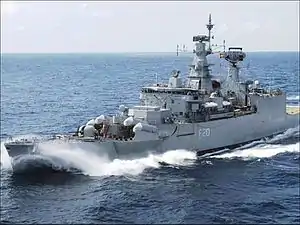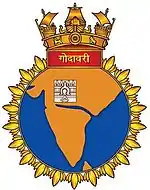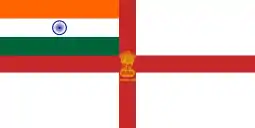INS Godavari (F20)
INS Godavari (F20) was the lead ship of her class of guided-missile frigates of the Indian Navy. Built by Mazagon Dock Limited in Mumbai, she was the first Indian warship to be indigenously designed and built. She was commissioned on 10 December 1983, and decommissioned on 23 December 2015 after a 32-year career.[1][3]
 INS Godavari | |
| History | |
|---|---|
| Name: | INS Godavari |
| Namesake: | Godavari River |
| Builder: | Mazagon Dock Limited |
| Laid down: | 3 November 1978 |
| Launched: | 15 May 1980 |
| Commissioned: | 10 December 1983 |
| Decommissioned: | 23 December 2015 |
| Status: | Awaiting disposal.[1] |
| Badge: |
 Seal of INS Godavari |
| General characteristics | |
| Class and type: | Godavari-class frigate |
| Displacement: |
|
| Length: | 126.4 m (414 ft 8 in) |
| Beam: | 14.5 m (47 ft 7 in) |
| Draught: | 4.5 m (14 ft 9 in) |
| Propulsion: | 2 turbines with 30,000 hp (22,000 kW) motors; 2 × 550 psi boilers; 2 shafts |
| Speed: | 27 knots (50 km/h) |
| Range: | 4,500 mi (7,200 km) at 12 knots (22 km/h) |
| Complement: | 313 (incl. 40 officers & 13 aircrew) |
| Sensors and processing systems: |
|
| Armament: |
|
| Aircraft carried: |
|
History
During the mid-1970s, the Navy's Directorate of Naval Design developed a concept for the next generation of frigates, which would supplant the British-designed Nilgiri-class frigates. The new Godavari-class frigates would be the first indigenously designed and built frigates, with vastly improved speed and firepower. As the lead ship of her class, Godavari was laid down on 3 November 1978 by the Chief of Naval Staff, Admiral Jal Cursetji, and was launched on 15 May 1980. She was commissioned on 10 December 1983.[4]
Operations

Notable operations involving INS Godavari include Operation Jupiter in 1988 (Sri Lanka), Operation Shield and Operation Bolster in 1994 (de-induction of Indian Army from Somalia), Patrol of Gulf of Aden (PoG) in 2009, and 2011 anti-piracy operations in the Gulf of Aden. The ship also visited New York harbour in July 1986 on the occasion of the bicentennial celebrations of the Statue of Liberty.
Operation Cactus
In 1988, following an attempted coup d'état against Maldivian President Maumoon Abdul Gayoom by Sri Lankan mercenaries, India launched Operation Cactus to restore the democratically elected government. After Indian paratroopers restored the presidency, the mercenaries captured Maldivian hostages on board a freighter and fled towards Sri Lanka. INS Godavari and INS Betwa successfully intercepted the freighter, rescued the hostages and arrested the mercenaries off the Sri Lankan coast.[5]
UNOSOM II
While the UN Security Council Resolution 954, extended the UN mandate for UNOSOM II in Somalia to March 1995, the United States and other NATO members of the mission abandoned the peacekeeping effort and withdrew from Somalia over a year earlier. As the mission approached its scheduled end, the situation on the ground continued to deteriorate. With no other international support forthcoming, INS Godavari along with INS Ganga and INS Shakti were deployed to Mogadishu in December 1994 to support the withdrawal of the Indian Army's 66 Brigade, including the 2nd Battalion, Jammu & Kashmir Light Infantry (2 JAKLI).[6]
Incidents
Pakistan Naval Ship Babur brushed with INS Godavari in June 2011 while escorting Egyptian ship MV Suez. This incident triggered a diplomatic row between India and Pakistan.[7]
Fate
In 2014, a naval review board decided Godavari would be decommissioned the following year. After 32 years of service, she was decommissioned on 23 December 2015.[1] A senior naval official said she would first be stripped of her weaponry and any salvageable fittings, and then most likely be sunk as a target ship.[8]
References
- "INS Godavari sets sail into the sunset after three decades". The Times of India. 21 December 2015. Retrieved 22 December 2015.
- Bedi, Rahul (20 April 2015). "India launches first-of-class Project 15B destroyer". IHS Jane's 360. Archived from the original on 4 March 2016. Retrieved 25 April 2015.
- "India's first indigenously designed and built Frigate INS Godavari to be Decommissioned". Indian Navy. 21 December 2015. Retrieved 23 December 2015.
- "India's first indigenously designed and built Frigate INS Godavari to be Decommissioned". Archived from the original on 19 June 2009. Retrieved 26 July 2009.
- "Somalia, 1992–1994". bharat-rakshak.com. Archived from the original on 11 October 2012. Retrieved 22 November 2018.
- "Archived copy". Archived from the original on 11 March 2012. Retrieved 18 June 2011.CS1 maint: archived copy as title (link)
- ""Godavari, 1st indigenously designed warship, calls it a day"". Brahmand.com. 24 December 2015. Retrieved 16 January 2016.
